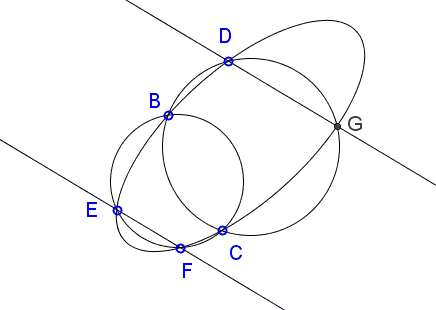Two Circles, Ellipse, and Parallel Lines
The problem below has been posted at the CutTheKnotMath facebook page by Cõ Gẫng Lên:
Given circles \(C_{CBEF}\) through \(B, C, E, F\), \(C_{BCGD}\) through \(B,C,D,G\), and ellipse \(E_{BEFCGD}\) through all six points.

Prove that the lines \(DG\) and \(EF\) are parallel.
|Contact| |Front page| |Contents| |Geometry|
Copyright © 1996-2018 Alexander BogomolnyGiven circles \(C_{CBEF}\) through \(B, C, E, F\), \(C_{BCGD}\) through \(B,C,D,G\), and ellipse \(E_{BEFCGD}\) through all six points.

Prove that the lines \(DG\) and \(EF\) are parallel.
I shall assume that \(C_{XYZW}\) also denotes the quadratic expression such that \(C_{XYZW} = 0\) is the equation of circle \(C_{XYZW}\) through points \(X,Y,Z,W,\) and similarly for ellipses. In particular, we are given circles \(C_{CBEF}=0,\) \(C_{BCGD}=0,\) and ellipse \(E_{BEFCGD}=0.\) In addition, a line through points \(X,Y\) will be denoted \(L_{XY}\) and defined by the equation \(L_{XY}=0.\)
The pencil of conics through four points \(B, C, E, F\)
\(\lambda C_{CBEF} + \mu E_{BEFCGD} = 0\)
contains a degenerate conic \(L_{BC}\cdot L_{EF} = 0,\) of two (intersecting or parallel) lines \(L_{BC}=0\) and \(L_{EF}=0,\) meaning that, for some fixed \(\lambda_1\) and \(\mu_1,\)
\(L_{BC}\cdot L_{EF} = \lambda_{1} C_{CBEF} + \mu_{1} E_{BEFCGD}.\)
Both \(L_{BC}=0\) and \(L_{EF}=0\) are linear equations.
Similarly, for some fixed \(\lambda_2\) and \(\mu_2,\)
\(L_{BC}\cdot L_{DG} = \lambda_{2} C_{BCGD} + \mu_{2} E_{BEFCGD}.\)
Combining the two equations we obtain
\(L_{BC}\cdot (\mu_{2}L_{EF} - \mu_{1}L_{DG}) = \lambda_{1}\mu_{2}C_{CBEF} - \lambda_{2}\mu_{1}C_{BCGD}.\)
Now, on one hand, equation \(\lambda_{1}\mu_{2}C_{CBEF} - \lambda_{2}\mu_{1}C_{BCGD} = 0\) defines a member of a pencil of circles through points \(B,C.\) This pencil consists of circles (through \(B\) and \(C\)) and their common radical axis \(L_{BC}.\) On the other hand, the left hand side determines the equation \(L_{BC}\cdot (\mu_{2}L_{EF} - \mu_{1}L_{DG})=0\) which defines either two or one line. The two sides may only be equal when both define the same single line which, of necessity, is \(L_{BC}=0,\) implying that \((\mu_{2}L_{EF} - \mu_{1}L_{DG})\) is constant. This is exactly the requirement for \(L_{EF}\) and \(L_{DG}\) to be parallel.
Note: The statement proved above admits an elegant generalization.
Conic Sections > Ellipse
- What Is Ellipse?
- Analog device simulation for drawing ellipses
- Angle Bisectors in Ellipse
- Angle Bisectors in Ellipse II
- Between Major and Minor Circles
- Brianchon in Ellipse
- Butterflies in Ellipse
- Concyclic Points of Two Ellipses with Orthogonal Axes
- Conic in Hexagon
- Conjugate Diameters in Ellipse
- Dynamic construction of ellipse and other curves
- Ellipse Between Two Circles
- Ellipse in Arbelos
- Ellipse Touching Sides of Triangle at Midpoints
- Euclidean Construction of Center of Ellipse
- Euclidean Construction of Tangent to Ellipse
- Focal Definition of Ellipse
- Focus and Directrix of Ellipse
- From Foci to a Tangent in Ellipse
- Gergonne in Ellipse
- Pascal in Ellipse
- La Hire's Theorem in Ellipse
- Maximum Perimeter Property of the Incircle
- Optical Property of Ellipse
- Parallel Chords in Ellipse
- Poncelet Porism in Ellipses
- Reflections in Ellipse
- Three Squares and Two Ellipses
- Three Tangents, Three Chords in Ellipse
- Van Schooten's Locus Problem
- Two Circles, Ellipse, and Parallel Lines
|Contact| |Front page| |Contents| |Geometry|
Copyright © 1996-2018 Alexander Bogomolny73563228
